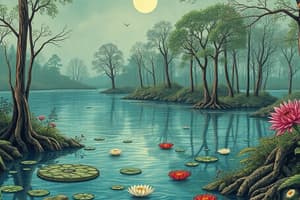Podcast
Questions and Answers
What type of lake is formed by the melting of glaciers?
What type of lake is formed by the melting of glaciers?
- Tectonic lake
- Glacial lake (correct)
- Artificial lake
- Riverine lake
Which factor does NOT affect a river's flow?
Which factor does NOT affect a river's flow?
- Dams
- Rainfall
- Photo period (correct)
- Snowmelt
What process significantly shapes a river's landscape?
What process significantly shapes a river's landscape?
- Evaporation
- Osmosis
- Filtration
- Erosion and deposition (correct)
Lake stratification primarily affects which of the following?
Lake stratification primarily affects which of the following?
Which term describes the area of land that drains into a river?
Which term describes the area of land that drains into a river?
What effect does nutrient levels and acidity have on a lake?
What effect does nutrient levels and acidity have on a lake?
What is defined as the volume of water flowing past a specific point in a river per unit of time?
What is defined as the volume of water flowing past a specific point in a river per unit of time?
Flashcards
What is a lake?
What is a lake?
A body of water surrounded by land, typically formed by natural processes like glacial activity, tectonic movement, or river erosion.
What is a river delta?
What is a river delta?
The process of a river flowing into a larger body of water, such as a lake or ocean, creating a fan-shaped deposit.
What is a watershed?
What is a watershed?
The area of land that drains into a river, including all the tributaries and streams that contribute to its flow.
What is river discharge?
What is river discharge?
Signup and view all the flashcards
What is lake stratification?
What is lake stratification?
Signup and view all the flashcards
How do rivers change their shape?
How do rivers change their shape?
Signup and view all the flashcards
What are tectonic lakes?
What are tectonic lakes?
Signup and view all the flashcards
What are glacial lakes?
What are glacial lakes?
Signup and view all the flashcards
Study Notes
Lakes
- Lakes are bodies of water surrounded by land, typically formed by natural processes like glacial activity, tectonic activity, or river erosion.
- Lakes range in size from small ponds to large, deep bodies of water.
- Types of lakes include glacial (meltwater), tectonic (earth movement), and riverine (river-formed).
- Lake morphology (shape and size) and bathymetry (underwater depth contours) affect water quality and biodiversity.
- Nutrient levels and acidity influence the organisms present.
- Lakes are crucial ecosystems, supporting diverse aquatic life and influencing surrounding environments.
- Lakes are vital sources of drinking water and support human activities like fishing and recreation.
- Lake ecosystems are vulnerable to pollution and human-induced changes.
- Inflow streams alter lake temperature and pH.
- Temperature layering (stratification) in lakes affects circulation and oxygen levels.
Rivers
- Rivers are flowing bodies of water carrying water from higher to lower elevations, fed by precipitation, groundwater, and meltwater.
- River systems have watersheds (areas draining into the river).
- Rivers are dynamic, constantly changing their shape and course.
- Rivers are crucial components of the water cycle, transporting water to oceans and impacting surroundings.
- River morphology (shape and size) varies based on gradient, discharge, and channel geometry.
- Rivers erode and transport sediments, shaping landscapes through deposition and erosion.
- River flow is influenced by rainfall, snowmelt, dams, and human activities.
- River velocity affects sediment-carrying capacity; faster flows carry more sediment.
- River characteristics differ based on surrounding geology and geography.
- River deltas form where rivers meet oceans or lakes.
- River discharge is the volume of water passing a point per unit time.
- Riverbeds are shaped by erosion, deposition, and the interaction of water and sediments.
- Human activities, like dam construction, significantly alter river flow and sediment transport.
- River ecosystems support diverse aquatic life and plant communities, with intricate food webs.
- Rivers carry nutrients and pollution.
- Rivers are vital for transportation, irrigation, and hydroelectric power generation.
Studying That Suits You
Use AI to generate personalized quizzes and flashcards to suit your learning preferences.



